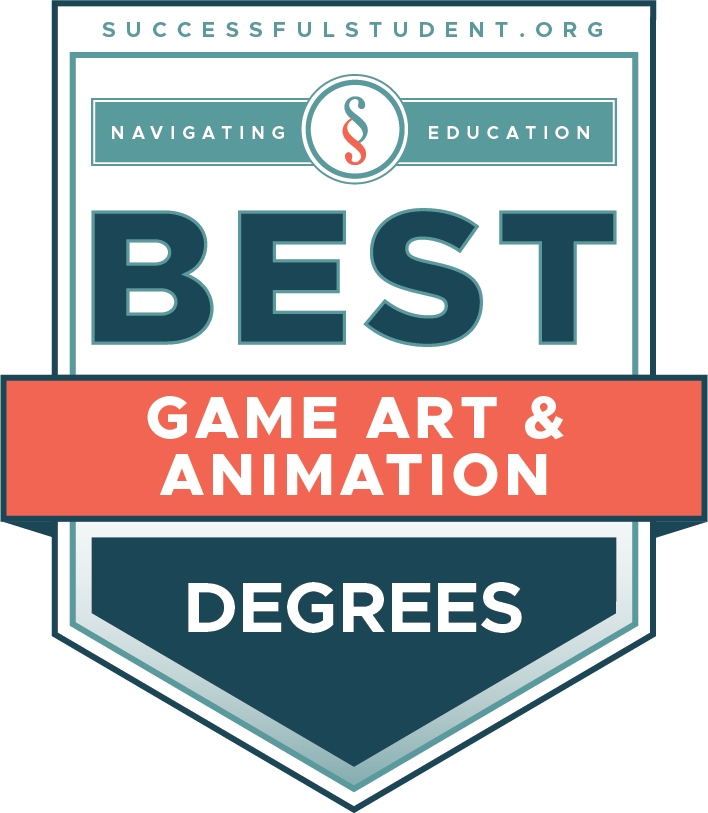| Rank | School | Location |
|---|---|---|
| 1 | Columbia College Chicago | Chicago, Illinois |
| 2 | Southern New Hampshire University | Manchester, New Hampshire |
| 3 | Rensselaer Polytechnic Institute | Troy, New York |
| 4 | University of Wisconsin-Stout | Menomonie, Wisconsin |
| 5 | Champlain College | Burlington, Vermont |
| 6 | University of Advancing Technology | Tempe, Arizona |
| 7 | Full Sail University | Winter Park, Florida |
| 8 | Fairleigh Dickinson University-Metropolitan Campus | Teaneck, New Jersey |
| 9 | Ringling College of Art and Design | Sarasota, Florida |
| 10 | Maryland Institute College of Art | Baltimore, Maryland |
| 11 | DePaul University | Chicago, Illinois |
| 12 | Regent University | Virginia Beach, Virginia |
| 13 | Woodbury University | Burbank, California |
| 14 | Monmouth University | West Long Branch, New Jersey |
| 15 | The University of Texas at Dallas | Richardson, Texas |
| 16 | Towson University | Towson, Maryland |
| 17 | Rocky Mountain College of Art and Design | Lakewood, Colorado |
| 18 | Becker College | Worcester, Massachusetts |
| 19 | Lynn University | Boca Raton, Florida |
Our ranking of The Video Best Game Art degrees in the U.S. is designed for students, parents, and guidance counselors to be informed of college and degree options.

These colleges offer on-campus and a few online programs in Video Game Art, which often includes instruction in Animation. This ranking is comprised mostly of bachelor's degrees in Game Art.
Creating game art for video games is an important part of the video game industry. As technology advances, so does the ability to create projects where students develop industry skills such as character design, how to create animated characters, animated sequences, and even virtual worlds.
Game Artists apply the technical skills of light, motion, texture, and more to the world of 2D and 3D character design to bring games into creation. Whether it is a single player or an online multiplayer role-playing game, each has an artistic element which requires the skill of a Game Artist. Game artists can work the gaming industry as a concept artist, for example. But there are also potential opportunities to work in other industries.
Students develop technical skills relevant to the artistic side of video game development. These skill sets include how to use game engines (such as Epic Games' Unreal Engine) and the practical application of computer technology towards game art.
Featured Game Art and Animation Colleges:
The Best Video Game Art Degree Programs
Ranking Methodology:
We selected the schools with the highest academic influence in game art and game animation, and factored in the particulars of each program (the degrees and variety of courses offered), and academic prestige.
Columbia College Chicago
Interactive Arts and Media
Chicago, Illinois

Columbia College Chicago offers the Bachelor of Arts in Game Art. Learners will begin creating games in the very first semester, and creating more throughout the degree. This includes gaining skills in creating 3D art and implementing them into a game engine.
Courses include:
- 2D Art for Games
- Advanced 3D Digital Sculpting
- Computer Animation: Modeling
- Fundamentals of Interaction
- 2D Motion for Games
- Character Visualization for Games
- Digital Image Design
The degree mimics industry professional collaboration and use of the same software tools. 54 credits are required, and a Capstone project.
Southern New Hampshire University
School of Arts and Sciences
Manchester, New Hampshire

As one of the most affordable private, nonprofit institutes for higher education, Southern New Hampshire University offers more than 200 online and on campus programs with a student-first approach to the curriculum.
One such comprehensive degree is the Bachelor of Arts in Game Art and Development offered through the School of Arts and Sciences. Here students will gain a well-rounded knowledge of video game art asset creation through classes such as:
- Concept Art and Color Theory
- 3-D Modeling and Animation
- Interactive Animation
- Environment Design
- Illustration
Motivated students can finish online bachelor's degrees at SNHU in 18 months, by using their Sophia Learning program, which allows students to work through basic classes at their own pace for a flat tuition rate.
Rensselaer Polytechnic Institute
School of Humanities, Arts, and Social Sciences
Troy, New York

Rensselaer Tech manages the School of Humanities, Arts, and Social Sciences which offers a Bachelor of Science in Games and Simulation Arts and Sciences. The total 128 required credits for this degree include:
- 36 credits for the major
- 36 credits in concentration courses
- 24 credits in Math and Science core courses
- 20 credits of electives related to the Humanities, Arts, or Social Sciences
- 12 credits of free electives
The core courses for the Games and Simulation Arts and Sciences concentration include:
- History and Culture of Games
- Art for Interactive Media
- Character and Story for Games
- Game Development I and II
University of Wisconsin-Stout
Menomonie, Wisconsin

The Bachelor of Fine Arts degree in Game Design and Development with a focus on Art offered at the University of Wisconsin encourages a hands-on learning experience through cutting edge facilities with state of the art equipment.
Students in this program have access to three different computer labs with equipment such as:
- AAA development kits
- Intuos Cintiq displays
- HD and 3-D projectors
- Virtual reality headsets
Accolades of the program include national co-champion as the E3 College Game Competition. The comprehensive and progressive nature of the program has lead both Princeton Review and Animation Career Review to rank this program as one of the best in the country.
Champlain College
Burlington, Vermont

At Champlain College, the Game Art and Animation degree offers an 'Upside-Down' curriculum where students can take up to six courses towards their major during their first year. This has the benefit of opening up early internship opportunities and a full portfolio for a highly marketable resume.
Students enrolled in this degree have access to the Game Studio, which allows for collaboration with students in related majors such as Game Programming and Game Design.
Additionally, the Emergent Media Center offers paid positions to Game Art and Animation majors as early as their freshman year for hands-on experience.
University of Advancing Technology
Tempe, Arizona

The University of Advancing Technology has created a unique, technology centered academic environment for the tech geek of toady seeking to create new and improved technology for tomorrow.
Classes are kept small, with the average attendance being 15 students, to encourage peer connections and a more personalized education from the professor.
The Bachelor of Art in Game Art and Animation degree is a comprehensive program which immerses students in the artistic principles of 3-D video game art.
Courses include:
- Color Theory
- Lighting and Shading
- Life Drawing and Anatomy
- Scene Staging
- 3-D Mesh Topology
- Motion Capture and Facial Animation
Full Sail University
Winter Park, Florida

Full Sail is one of the premiere entertainment educators in America. Their Bachelor of Science in Game Art can be completed on campus or entirely online. This will take students an average of 20 months to complete on campus or 29 months to complete online.
The detailed curriculum will cover essential topics to help students master traditional art and animation principles.
Students will then be able to effectively apply these skills to 3-D models for a realistic outcome, which can be added to an ongoing portfolio that will be built up each semester.
Career development modules are interspersed throughout the curriculum to help student build connections to the industry and work field.
Fairleigh Dickinson University-Metropolitan Campus
Teaneck, New Jersey

At Fairleigh Dickinson University, the Visual and Performing Arts Department offers a Film and Animation major with a Video Game Animation concentration.
The curriculum emphasized the more artistic side of video games concentrating on the visual and design components in addition to learning the necessary software.
Students will become familiar with programs such as 3-D Studio Max, Unreal Engine, Unity and ZBrush.
There are 42-45 credits required for the major with courses such as:
- Motion Graphics with After Effects
- 3-D Asset Creation for Video Games
- 3-D Particle Animation and Effects
- Logo and Product Animation
- Custom 3-D Character Rigging and Animation
Ringling College of Art and Design
Sarasota, Florida

Though small is size, with a total enrollment of approximately 1,400 students, Ringling College of Art and Design has been making large strides in the area of visual and technological arts.
The College offers a four year Bachelor of Fine Arts in Game Art degree which requires 120 credits for graduation. The curriculum of the degree focuses on designing, creating, and analyzing the visual art for computer and video games.
Some of the courses for the major include:
- 3-D for Games I, II III, and IV
- Game Design I, II, and III
- Programming for Artists
- Visual Development for Games I and II
- Traditional Animation
Each year, students attend the Game Developers Conference that's held in San Francisco and showcase their work and take advantage of networking opportunities.
Maryland Institute College of Art
Baltimore, Maryland

As part of the Interactive Arts major, the Maryland Institute College of Art offers a Game Arts Studio Concentration. The curriculum focuses on two main areas of gaming, Art and Design. The Art classes will use concepts of drawing and painting as applied to the digital world.
Students will gain experience critiquing the function of art in various modalities. The Design classes focus more on game theory and developing gaming systems. In total students will have to complete 15 credits for the Game Arts Studio concentration.
Required courses include:
- 2-D Game Studio
- 3-D Game Design
- Level and Narrative Design
- Virtual and Augmented Realities
- TableTop Game Studio
DePaul University
Chicago, Illinois

Through the College of Computing and Digital Media at DePaul University students may enroll in the Bachelor of Fine Arts in Animation which offers a concentration in Game Art.
As part of the total undergraduate credits for this degree, students must dedicate a minimum of 20 credits towards the focus area. Courses for the specialization may include:
- Advanced 3-D Character Animation
- Hand-drawn Character Animation
- Animation Production
- Making Comics
Students enrolled in the Game Art concentration are also required to take three Studio Art courses such as:
- Beginning Sculpture
- Watercolor Painting
- Screen Printing
- Advanced Figure Drawing
Regent University
Virginia Beach, Virginia

Supported by a Christian foundation and encouraging academic environment, students at Regent University have access to 128 graduate and undergraduate areas of study offered both online and on campus.
The College of Arts and Sciences offers the Bachelor of Arts in Animation on campus only, though weekend and evening classes may be available.
This program requires a minimum of 120 credits with tuition currently set at $555 per credit hour for full-time on campus students.
Courses for this degree include:
- Composition and Sound for Animators
- The Art of the Storyboard
- Advanced 3-D Animation Techniques
- Digital Special Effects for Film and Television
- The Business of Animation
Woodbury University
Burbank, California

The Bachelor of Fine Arts in Game Art and Design at Woodbury University is offered through the School of Media, Culture, and Design. The program has been regionally and nationally recognized by the Animation Career Review as one of the best degrees of its kind.
Students may choose to specialize in specifically Game Art or Game Design as they progress through the degree. Game Art focuses on character and environmental design while Game Design focuses on game conceptualization and play mechanics.
Internships are a required element for graduation.
Core courses for both specializations include:
- Game Fundamentals
- Game Design Documentation
- Game Prototyping
- Sound Synthesis and Design for Games
Monmouth University
West Long Branch, New Jersey

The School of Humanities and Social Sciences at Monmouth University is comprised of 10 departments. One of these is the Department of Art and Design. Here students can enroll in the Bachelor of Fine Arts in Design and Animation with concentration in Animation.
The curriculum covers a variety of relevant and engaging topics such as:
- Storyboarding
- Sequencing
- 3-D Model Development
- Rendering, Animation, and Sound
Classes may include:
- Digital Illustration
- Principles of 3-D Animation
- Animation/Motion Graphics I and II
- Advanced Digital Imaging and Illustration
A similar Graphic and Interactive Design concentration is also offered. Students in this specialty area will be exposed to motion graphics, web design, creative book arts, fine art imaging, and more.
The University of Texas at Dallas
Richardson, Texas

The University of Texas School of Arts, Technology, and Emerging Communication offers a comprehensive Bachelor of Arts in Arts and Technology with a concentration in Gaming.
The 120 total credits include 45 credits for the major and 33 credits for electives giving students an academic flexibility for a variety of concentrations and areas of specializations. Courses for the major and concentration may include:
- Computer Graphics for Artists and Designers
- Digital Content Design and Usability
- Photography
- Virtual Environments
- User Experience Design for Games
Throughout the curriculum, students will be exposed to not only the creation and design of games, but also the cultural implications of interactive media.
Towson University
College of Fine Arts and Communication
Towson, Maryland

At Towson University in the College of Fine Arts and Communication, students may enroll in the comprehensive Bachelor of Fine Arts Art and Design major, which offers a Digital Art and Design concentration.
There are 21 required units for all Art and Design majors and an additional 60 units for the concentration. There are three additional areas of focus offered within the concentration:
- Animation
- Digital Arts
- Experimental
Examples of possible courses focusing on digital art and design include:
- Illustration principles for designers and illustrators
- History of Modern Design
- Interactive Media: Theory and Application
- Digital Object Design
- Photo Imaging - Advanced Motion
Rocky Mountain College of Art and Design
Lakewood, Colorado

Since its founding in 1963, the Rocky Mountain College of Art and Design has had a passion for educating students in the creative arts. The current Bachelor of Fine Arts in Game Art degree has merged technical and artistic coursework into one comprehensive program.
Students are expected to complete 123 credits for graduation, which include:
- 15 credits Art History classes
- 30 credits Liberal Arts classes
- 24 credits Foundation classes
- 48 credits Core classes
- 6 credits Studio electives
Courses for the major will cover the principle topics of:
- 3-D Modeling
- Visual Storytelling
- Level Design
- Lighting and Texture
- Character Rigging and Animation
- Business Ethics and Copyrights
Becker College
Worcester, Massachusetts

At Becker College, the Bachelor of Arts in Interactive Media Design with a Game Arts concentration is offered by the School of Design and Technology. This traditional four year undergraduate degree requires 121 total credits for graduation.
Course examples may include:
- History of Game Development
- Digital 3-D Modeling
- Life Drawing
- Game Industry Trends
- Game Studio
Students in this program also have access to the Massachusetts Digital Game Institute. This facility is a statewide research center which opens up opportunities for networking, collaborative research, academic cooperation, and more. After graduation, students from this program have gone on to work for companies such as:
- Blizzard StudioX
- Demiurge Turtleboy Games
- Harmonix Horseplay
- Nukefile
Lynn University
Boca Raton, Florida

At Lynn University, students will be exposed to all aspects of the gaming and animation design process in the Bachelor of Fine Arts in Computer Animation with concentration in Game Art degree.
Concepts covered in the program include:
- Screenplay writing
- Storyboarding
- 3-D modeling
- Texturing and animating characters and environments
- Use of cinematic lighting
- Technical direction
Students in the Game Art concentration will focus specifically on:
- Character modeling
- Concept art
- Texturing for games
- Lighting
- Animation
- Strategic planning
A total of 29 credits should be dedicated to the concentration with a total of 127 credits for the complete undergraduate degree.
Career Information for Game Designers and Graphic Artists:
According to the Bureau of Labor and Statistics, Animation is a career field that is projected to grow at 8% over the next decade, adding 7,400 more positions. The average annual salary is $99,060 for Special Effects Artists and Animators.
The yearly median wage for Graphic Designers was $58,910, with a 3% job growth, adding 8,900 new positions.
Though some artists work in a company office, it is also common for artists to be able to work from home.
Game studios, such as Epic Games, usually have job postings on their websites. You can see if they're hiring for any game artist jobs.
Many game industry employers will require the minimum of a bachelor's degree in game art, computer graphics, or a similar field. However it is the talent of the artists which will likely be the most important factor.
Game Art
1. Introduction to Game Art
This information is useful to the prospective game animator to determine what's involved in game art. This includes learning about larger categories of art. These categories include:
- Tech Art
- Concept Art
- Environment Art
- Animation
- Visual Effects
- Sound Design
- UI Design (User Interface Design)
- Game Design
2. Concept Art
Concept art helps illuminate and clarify ideas. These ideas can come from any team or department within a game design project. Concept art takes the more ephemeral idea and develops it into the conceptual framework by visually representing the ideas in art.
Because these ideas originate with people other than the artist, there is a lot of communication and refining in the art as it's developed. The concept art aspect is crucial to fleshing out and developing new ideas and paths forward in making new games.
3. Character Art
As the name indicates, Character Art involves creating and refining the characters that appear in game design. This can include 2D or 3D art for characters, depending on the game type and needs. Character artists provide the texturing and scale of the characters, bringing them to life.
4. Environment Art
As the name indicates, Environment Artists create the environment and settings in which the games take place. This includes world-building, which includes most of the visual field of games. The entire setting and environment needs to be created. Environment artists are the liaisons between the Concept Artists and the Game Designers.
5. Tech Art
Tech Artists are the artists that can also code and program in programming languages as part of the artistic process. There are degrees in Computer Science and Information Technology, which teach the technical aspects of game design.
See our ranking of The Best Bachelor's Degrees in Computer Science: Game Design for the best technical degrees in Game Design within Computer Science programs.
6. Character Animation
Character Animation is bringing the game characters to life, in concert with the overall game theme. There is a lot of variation in the actions (or inactions) of characters, so artists need to know how to develop these elements.
This ability includes bringing the characters to life, and differentiating them from other characters. The characters also need to be believable and consistent in their motions.
7. Visual Effects
The Visual Effects artist determines how to take the visual elements in the game and make them intelligible and serve their purposes within the game. A cannon ball needs to be intelligible as a cannon ball. A river needs to be intelligible as a river.
Trees need to look like trees in order to be considered trees by the user. One key component to the affective valence of the visual effects is in their proportion to each other.
Certain elements may need to be visually muted or suppressed so that other effects in their vicinity become all the more salient and stand out. This contrast lends itself to the dynamics and enthusiasm of the user experience.
8. Sound Design
Sound Designers provide all of the audio elements to games. These include sound cues which are communicating something to the user that's occurring in the game (such as danger or reward), thematic sounds (is the game epic, lighthearted, or dark and scary, etc.), excitement, tension, resolution, and user feedback.
9. User Interface Design
User Interface Design refers to the interactive interface elements in games. These interfaces include elements such as a legend, or a map, or a remaining life percentage, or a weapons and ammunition counter, and so on. These interfaces are often interactive and serve a specific purpose to the user to navigate and understand the game.
10. Game Design
Game Design involves developing the overarching game concept and architecture. This includes developing game elements such as the purpose, plot, user experience, theme, and game mechanics. Art is an integral part of this architecture. Game Artists supply the thematic artistic elements that comply with the mechanics and plot.
Career Information for Game Designers:
Game Designers nationwide earn an average salary of $95,298 per year, according to Indeed.com.
Game Designers at the low end of the average salary distribution earn approximately $62,000, whereas the designers at the high end of the average salary range earn approximately $146,000 per year.
In Pennsylvania, Game Designers earn an average of $63,870 per year, with a lower average of $59,108, and an upper average of $69,015 in the income distribution, according to Indeed.com.
More resources:
- The Best Bachelor's in Computer Science: Game Design Degrees
- The Best Online Certificates in Game Design
- The Best Online Associate's Degrees in Game Design
- The Best Online Screenwriting Colleges
- The Top Women in Game Design and Development
- What Do Game Designers Earn? Salary Information
- The Best Game Design Colleges at Christian Colleges
- The Best Online Animation and Graphic Design Colleges
- The Best App Development Colleges
- The Best Artificial Intelligence Colleges: AI Degrees and Certificates
- The Best Online Artificial Intelligence Degrees
- The Best Online Video Game Design Degrees
- The Best Bachelor's Degrees in Computer Science: Game Design
Rankings by state:
